The World after World War II | History - Consolidation and Expansion of European Community | 12th History : Chapter 15 : The World after World War II
Chapter: 12th History : Chapter 15 : The World after World War II
Consolidation and Expansion of European Community
Consolidation and Expansion of European Community
In pursuance of its policy of containment of
communism, as we have seen, the USA came out with the Truman Doctrine and
Marshall Plan to support the war-torn European countries to reconstruct their
economy. An organisation, OEEC (Organisation for European Economic Cooperation)
was formed in April 1948 to overseer the disbursement of Marshall Aid under the
auspices of the European Recovery Programme (ERP). The OEEC disbursed aid to
its sixteen member countries. The US wanted the OEEC to remove tariff barriers
between themselves so that it was easier for American companies to do business.
OEEC obliged and followed free trade in 1949 for obtaining further financial
aid. With the US aid, by 1950, the western European countries had returned to
their pre- war production levels. The success made them to move forward and
OEEC transformed itself into the OECD (Organisation for Economic Cooperation
and Development) in 1961, adding the USA and Canada to the original membership
of West European countries. Japan joined in 1964.
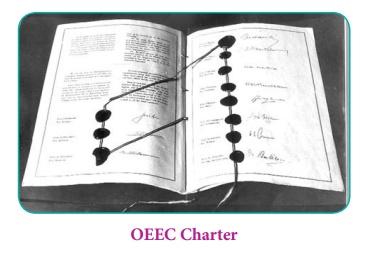
Today there are thirty-seven member countries in
OECD from all around the world. Most of them are developed countries. They are
all committed to the concept of free market economy and democracy. It has its
headquarters in Paris.
Towards European Union
Council of Europe
One of the momentous decisions taken in the
post-World War II era was to integrate the states of western Europe. In May
1949 ten countries met in London and signed to form a Council of Europe. The
Council of Europe with headquarters at Strasbourg was established with a
committee of foreign ministers of member countries and a Consultative Assembly,
drawn from the parliaments of foreign countries.
European Coal and Steel Community (ECSC)
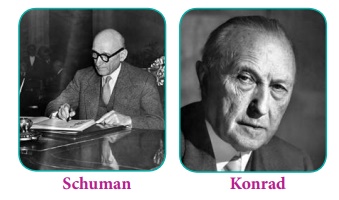
Robert Schuman, the French foreign minister,
realised that a reconciliation between France and Germany was good for both and
for reconstruction of post-War Europe. He presented a plan known as Schuman
Plan on 9 May 1950. Accordingly, he proposed that the joint output of coal and
steel in the two countries be placed within the framework of a strong,
supranational structure, the High Authority. This plan for sectoral economic
integration created mutual interests and automatically linked the two
countries. West Germany's Chancellor, Konrad Adenauer, welcomed the plan to
come close to the Western world.
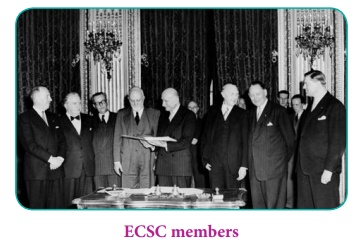
On 18 April 1951 France, West Germany, Italy, the
Netherlands, Belgium and Luxembourg signed a treaty at Paris to establish the
European Coal and Steel Community (ECSC). All duties and restrictions on trade
in coal, iron and steel between the six were removed. ECSC was the first step
towards European Integration. Britain refused to join ECSC since it would mean
handing over control of their industries to an outside authority. Steel
production rose by almost 50 per cent during the first five years of ECSC. The
success made them to include the production of all goods. Spaak, the Foreign
Minister of Belgium wanted gradual removal of all customs duties and quotas so
that there would be free competition and a common market. Six countries
belonging to ECSC signed the treaty of Rome which established the European
Economic Community (EEC) or the European Common Market, with headquarters at
Brussels. Britain did not join the EEC.
European Economic Community (EEC)
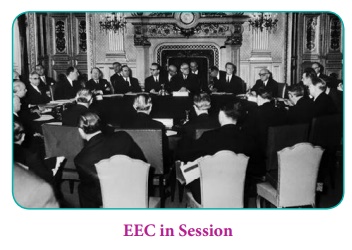
The EEC facilitated the elimination of barriers to
the movement of goods, services, capital, and labour. It also prohibited public
policies or private agreements that restricted market competition. A Common
Agricultural Policy (CAP) and a common external trade policy were evolved. In
1960, Britain organised a rival organ known as the European Free Trade
Association (EFTA) with Britain, Denmark, Norway, Sweden, Switzerland, Austria
and Portugal as members. But EFTA was weak since there were no common economic
policies and no authority to intervene in the internal affairs of states.
In 1961 Britain decided to join EEC but the French
President Charles de Gaulle opposed the entry because the economy of Britain
was weak. After his resignation, British Prime Minister Edward Heath, with his
skilful diplomacy, made way for Britain's entry. Britain was finally admitted
on 1 January 1973 along with Ireland and Denmark.
Single European Act (SEA)
The Single European Act that came into force on
July 1, 1987 expanded the EEC’s scope further. It called for more intensive
coordination of foreign policy among member countries. According to the SEA,
each member was given multiple votes, depending on the country’s population.
Approval of legislation required roughly two-thirds of the votes of all
members. The new procedure increased the power of European Parliament, which
had been functioning since 1952. Specifically, legislative proposals that were
rejected by the Parliament could be adopted by the Council of Ministers by a
unanimous vote.
European Union (EU)
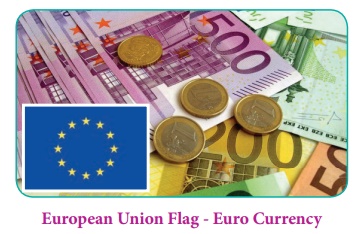
In December 1991 the members of EC came together
and signed the Treaty of Maastricht by which the European Union was established
in 1993 with a single market. With the establishment of European Union, the
members worked on other areas such as foreign policy and internal security.
This treaty paved the way for the creation of a single European currency – the
euro. In 2017, Britain voted to exit the EU (British Exit known as “Brexit”).
Today the European Union has 28 member states, and functions from its
headquarters at Brussels, Belgium.
End of Cold War
The US and the Soviet Union had created a bi-polar
international structure. Initially the Soviet military capabilities were weak.
But by 1969 USSR had equalled US in terms of nuclear capability. The threat of
Mutual Assured Destruction (MAD) created fear in both powers. Moreover, the
nuclear race was expensive and cost them heavily. The earmarking of larger
portions of their budgets for defence caused a resource crunch. Strong
disarmament movements in Europe also put pressure on the ruling governments.
This pushed the superpowers to the negotiating table.
The period from the late 1960s to the late 1970s is
known as period of détente (temporary stoppage of hostility). The period
witnessed increased trade and cooperation between the US and the Soviet Union.
The Strategic Arms Limitation Talks (SALT 1972 & 1979) and later the
Strategic Arms Reduction (START, 1991) treaties heralded an era of coexistence
and cooperation.
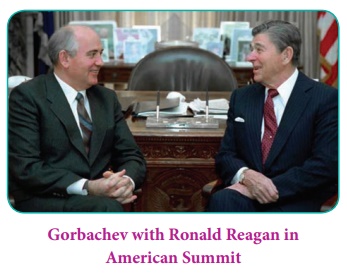
With the election of Mikhail Gorbachev as the
President of USSR in March 1985, there were phenomenal political and social
changes in the Soviet Union. Gorbachev committed himself to reforms. In
February 1986 he spoke in the Communist Party Congress, explaining the need for
political and economic restructuring, or perestroika,
and called for a new era of transparency and openness, or glasnost. By Perestroika Gorbachev
loosened centralised control of many
institutions, allowing businesses, farmers and manufacturers to decide for
themselves which products to make, how much to produce, and what to charge for
them.
Glasnost was
instituted as a part of an effort by
Gorbachev to democratise the governing structure of Soviet Union. Fundamental
changes occurred in the political structure of the Soviet Union: reduction of
the power of the Communist Party, and multicandidate elections for assembly
membership. Glasnost also permitted criticism of government officials and
allowed the media freer dissemination of news and people free expression of
their opinions. With glasnost, Soviet citizens no longer had to worry about
arrest and exile for articulating negative opinions against the State. These
ideas created a revolutionary wave of liberalism in Soviet Union. At the same
time, it eventually led to the disintegration of Soviet Union.
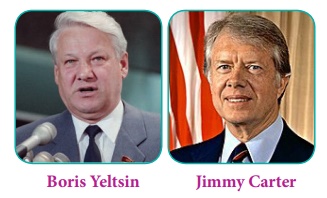
1989 was a watershed year in the Cold War era. Free
elections were conducted in Poland. The Polish Solidarity movement won the
election, routing the Communists. In July Gorbachev, speaking at the Council of
Europe, remarked that he rejected the Brezhnev Doctrine: “Any interference in
domestic affairs and any attempts to restrict the sovereignty of states, both
friends and allies or any others, are inadmissible.” In November 1989, one of
the most famous symbols of the Cold War, the Berlin Wall came down. In late
November 1989 West German Chancellor Helmut Kohl, without consulting any
allies, suddenly announced a ten-point programme calling for free elections in
East Germany and the eventual “German reunification". By the end of the
1989 a popular uprising took place in Eastern Europe and most of the leaders
were ousted except in Bulgaria. Slowly Eastern Europe severed its affiliation
with communism. This was taken as a clue by many Soviet Republics and by
mid-1990 many of them declared themselves as independent states. On December 8,
1991, the Soviet Union disintegrated. On 25th December Gorbachev resigned,
Boris Yeltsin became the President of the Russian Republic. With the
disintegration of USSR the Cold War came to an end.
Boris Yeltsin (1931–2007): Joining
the Communist Party in 1961, Yeltsin became a full-time worker in the party in
1968. In the seventies he emerged as a popular figure and began to occupy in
key positions in the Party. After Gorbachev came to power, he chose Yeltsin
(1985) to eliminate corruption in the Moscow party organisation. In 1986
Yeltsin was elevated to the Politburo (the highest policy making body of the
Soviet Union). Soon he was made the mayor of Moscow. Yeltsin antagonised
Gorbachev when he began criticising the slow pace of reform at party meetings.
His popularity with the people grew as he advocated democratisation of
governance and economic reform. He succeeded in winning a seat in the USSR
Congress of People’s Deputies (the new Soviet Parliament) in March 1989. A year
later, on May 29, 1990, the Soviet parliament elected him president of the
Russian republic against Gorbachev’s wishes. He became the first popularly
elected leader in 1991, after the collapse of Soviet Union.
Related Topics